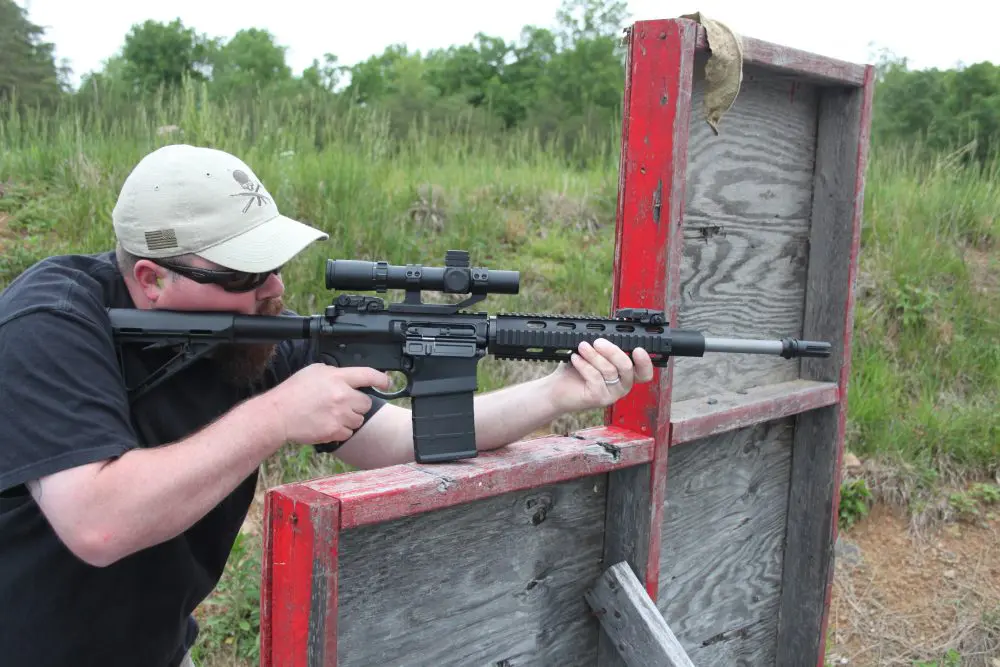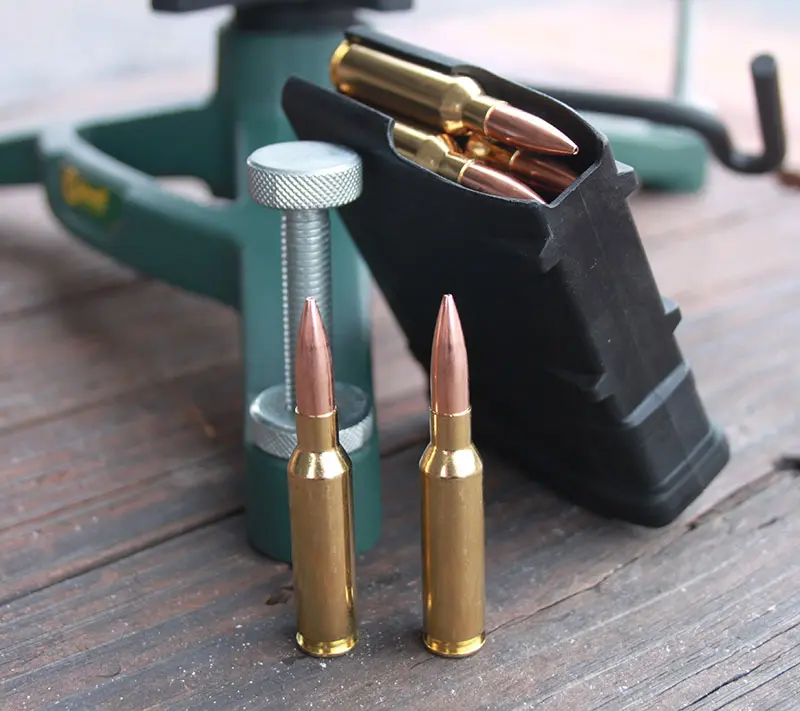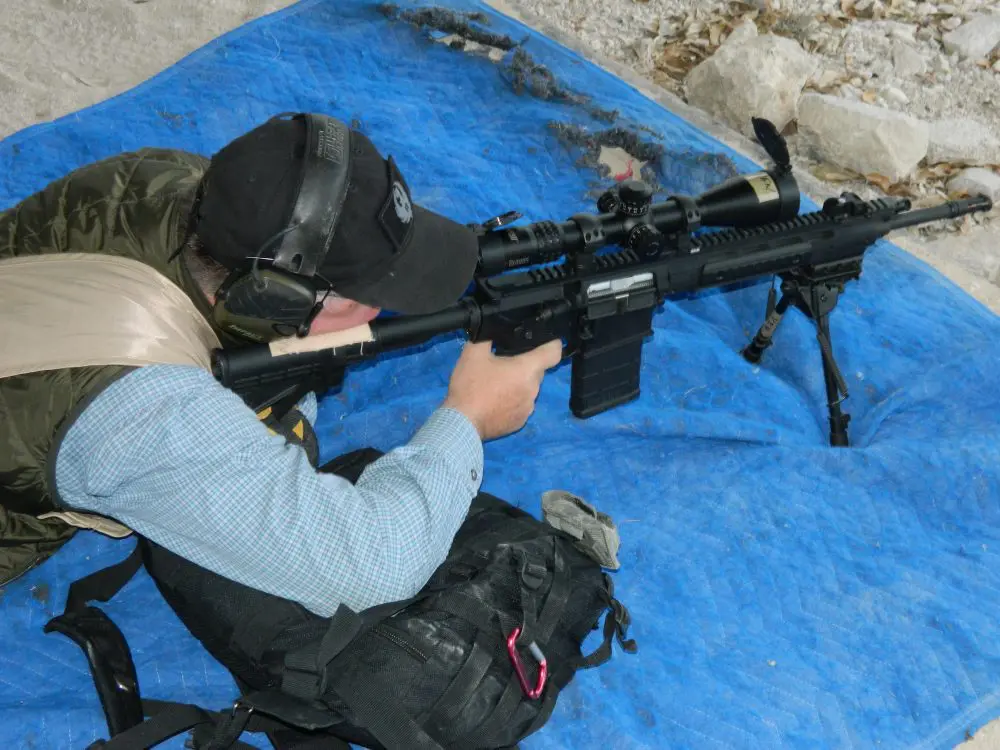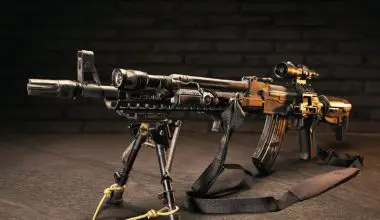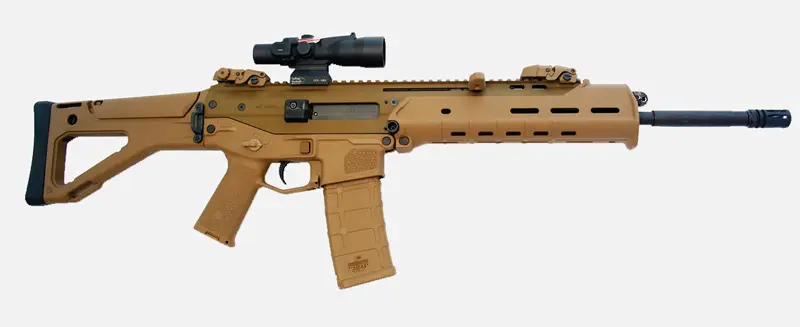
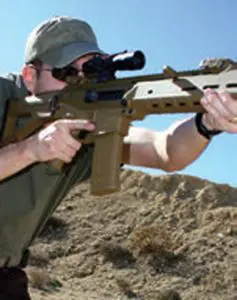
I was one of those guys who started saving money when the Magpul Masada was first announced at SHOT 2007, since it was the first rifle to incorporate enough extra features to successfully draw my attention away from the AR-15. However, the initial price at its January 2010 release was so outrageous that I gave up purchasing the rifle. Finally, I was able to afford the rifle a year and a half later, when the street price for the ACR Basic dropped close to Magpul’s original projections. (The Masada was originally a Magpul design. Magpul sold the rights to build the rifle to Bushmaster, which dubbed it the Adaptive Combat Rifle, or ACR.) While happy the rifle finally materialized, I was a bit concerned about all the design modifications from the original Masada prototype.
Table of Contents
FIRST IMPRESSIONS
The ACR is available in five configurations: Basic ORC, A-TACS Basic, Basic Folder, Basic State Compliant, and Enhanced. I went with the Basic ORC model because I prefer the longer plastic forend to the shorter rails. The plastic forend is longer, more comfortable, still free floats and felt lighter side by side with the Enhanced model. The Basic forend is also compatible with Magpul’s MOE handguard for users needing to attach lights, foregrips and other equipment that would normally require rails. I also really like the fixed ACR stock—it’s the exact same length that I normally adjust all of my collapsible AR stocks.
As nice as six-pound rifles are to carry around, I actually prefer the shooting characteristics of rifles in the seven- to eight-pound range. The Basic is a tad on the heavy side at eight pounds, five ounces, but it balances well near the front of the mag well.
The puzzling M4 barrel profile appears to the main culprit. Not only is the useless M203 cutout an eyesore—at least to me—but shifting the barrel mass away from under the forend toward the muzzle puts that mass where it is most useless and causes the front-heavy feeling that has drawn criticism from some people. The 1:9 barrel twist is another puzzling feature for a rifle with ambitions of military service. Luckily, Bushmaster plans to have lighter weight 1:7 twist barrels available in the first quarter of 2012.
Bushmaster forwent chrome lining the barrel and chamber in favor of a nitride treatment on the inside and outside of the barrel as well as the action components. Theoretically, this should allow a more accurate barrel, since it offers the corrosion resistance of chrome lining with the uniformity of unlined barrels. If the nitride proves to be as corrosion and wear resistant as Glock’s similar Tennifer treatment, then I look forward to taking advantage of it, especially with the self-lubricity that Bushmaster claims.
For me as a left-handed rifle shooter, the ACR’s ambidexterity was a huge personal selling point. I love the ambidextrous safety, magazine release and bolt release, but am not sure why they stopped there. The front QD sling attachment point is ambi, but the rear and single-point sling attachments are not. Similarly, the non-reciprocating charging handle is also swappable instead of ambi. However, I do like the forward charging handle location, which makes it quick to operate and out of the way of optics.
The ACR attributes its modularity to the quick-change stock, forend, and barrel. The stock and forend are absolutely ingenious. While both are rock solid, they can each be swapped simply by pushing a single pin. I really like the feel of the Basic forend—especially the length—since I prefer a far forward hold with my support hand.
The quick-change barrel is neat, but I believe that tool-less quick-change barrels are highly overrated on semiautomatic rifles. Thirty-second barrel swaps to different barrel lengths or even different calibers are meaningless when it still requires a 30-minute range trip to rezero the sights.
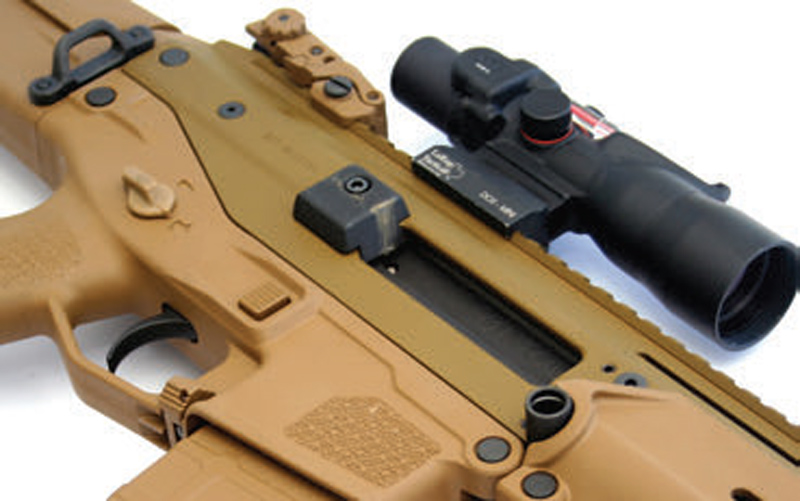
The bolt release was easily manipulated with the trigger finger on an empty magazine, but I found using the support hand thumb to actuate the release was consistently easier with a full magazine. The bolt hold open manipulation offered by the ACR’s bolt release solves a huge AR weapon manipulation by allowing the user to lock the bolt back without breaking the firing-hand grip.
FAMILIARIZATION
In an effort to test the nitride’s self-lubricity, I did not clean, oil or perform any other preventive maintenance on the ACR before shooting, and I planned on leaving it dry and dirty until failure. After zeroing the included Magpul BUIS, I quickly noticed the extra mechanical sight offset at ten yards. Rounds were impacting over three inches low compared to the 2.5-inch offset of the AR. I measured the height over bore of the irons at 3.15 inch, which is over half an inch higher than irons on an AR. I adjusted my point of aim and continued.
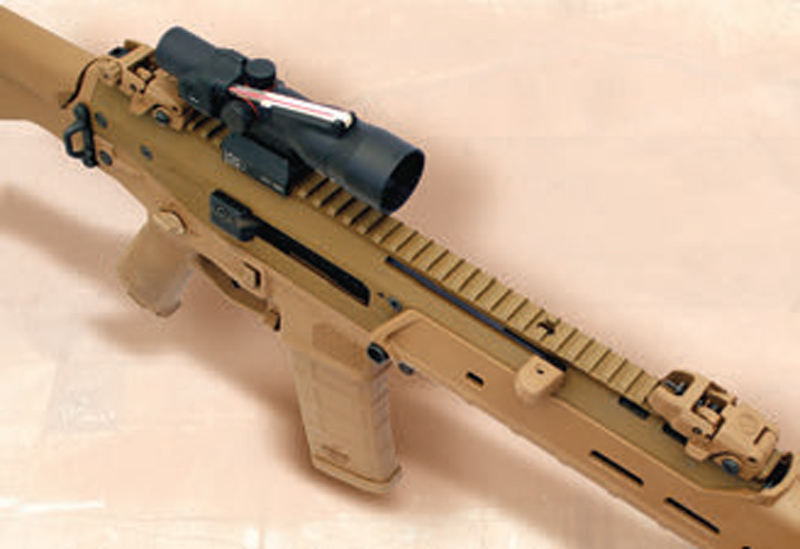


A technique I use with iron sights on the AR at close range is to look over the rear sight and align the tip of the front sight with the top of the rear aperture to account for sight offset and allow a quicker sight picture. This carried over successfully to the ACR despite the height over bore difference.
CLOSE-RANGE EVALUATION: AR-15 vs. ACR
Close-range evaluation comprised Viking Tactics 2x2x2 and Triple Threat drills, an El Presidente drill, Bill Drill, and Par Time drill. I performed each drill three to five times with the ACR and AR-15, recording each drill’s average total time, split time, target transition time and reload time when applicable.
The comparison AR-15 was a Daniel Defense M4, which is the AR-15 most similar to the ACR that I own (iron sights, 16-inch M4 profile barrel, 12-inch free floating rails, Magpul CTR stock, and A2 flash hider).
I discovered that while the ACR does not have more recoil than the AR, the shooter does feel more going on during the ACR’s recoil impulse, possibly due to the larger interior reciprocating mass and/or heavier recoil springs. The ACR actually had a much less mild rearward impulse and less muzzle rise than the AR, but the tradeoff was that instead of a muzzle rise, the ACR exhibited more of a side-to-side muzzle shake.
The effect of the AR’s muzzle rise versus the ACR’s muzzle shake was apparent in the average split times of the above drills. Firing only two rounds at closer ranges during the 2x2x2 drill was quicker with the AR due to the relatively tall A zone on the standard IPSC target, and I did not have to wait for the muzzle to fully recover before breaking my second shot to still attain an A zone hit.
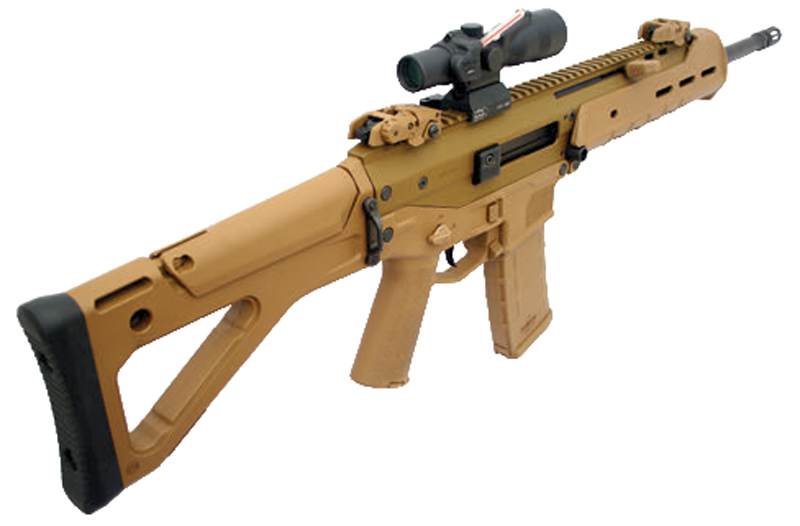
However, as the distance or number of rounds in succession grew larger, the AR’s muzzle rise had more of an effect, since I had to wait a bit longer for the muzzle to recover to keep hits in the A zone. While that second shot may have still been an A zone hit at close range, successive shots may not have been without allowing more time for the muzzle to recover.
Conversely, the ACR’s side-to-side muzzle shake kept moving steadily back and forth with additional rounds and did not continuously jump one direction or another. This meant that additional shots did not result in additional muzzle drift due to recoil. I believe that with practice, the ACR’s side-to-side muzzle shake could be better controlled than a non-braked AR-15’s muzzle climb, resulting in possibly better overall muzzle control.
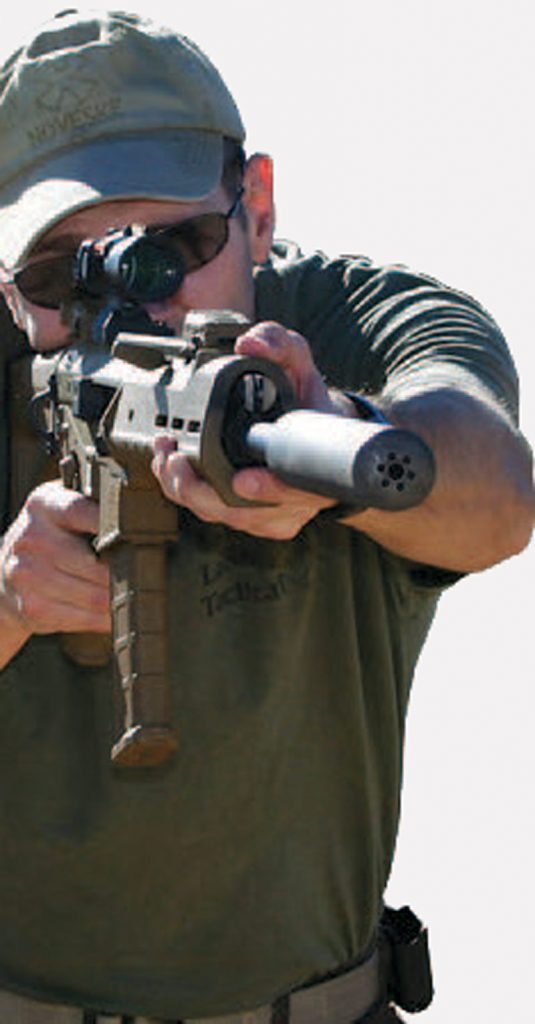
This muzzle control manifests itself during the Par Time Drill, which is a drill I use to evaluate my grip and stance as well as measure the effectiveness of recoil reduction devices like muzzle brakes. The drill is simply testing how many rounds I can put into the A zone from seven yards in two seconds from the low ready. Eight rounds is about my average with a standard AR-15 carbine using a good stance and no muzzle brake, yet my first attempt with the ACR was ten rounds in the A zone.
Transitions between targets felt slower with the ACR, but the shot timer proved that the differences were negligible. Reload times demonstrated during the El Presidente drill were very telling. Being a left-handed rifle shooter, I found the ACR’s bolt release very convenient. Emergency reloads were much faster (.66 seconds on average) than an AR, even with my relative unfamiliarity with the ACR platform.
ACCURACY TESTING
Once I had completed all closerange testing, I mounted a Trijicon TA33 ACOG and zeroed at 100 yards. I fired several ten-shot groups at 100 yards from the bench using Hornady 75-grain OTM and was a bit alarmed at the size. Most hits were in about a 1.5-inch clump in the center, but there were sporadic hits around the edges that extended the extreme spread of the groups to almost four inches.
I slipped off the handguard and tightened the barrel nut as much as I could with hand pressure. The barrel nut ratchet had been directly at six o’clock from the factory, and I was able to tighten it three clicks to about 6:30.
Thankfully, I noticed a drastic difference. The ten-shot groups shrunk to under two inches. The ACR seemed to prefer 69-grain Federal Gold Medal Match (FGMM), with average 1.50-inch ten-shot groups.
Bored with shooting paper, I moved on to steel LaRue targets at longer range. LaRue targets are only 11 inches wide but still made for easy hits at the 250- yard line. The ACR/ACOG proved to be a versatile combo and kept up a high hit ratio on LaRues at the 500-yard line.
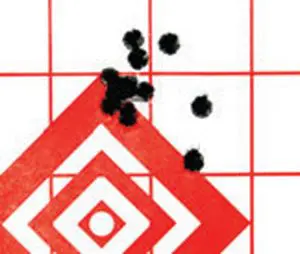
MAGAZINE MONOPOD TEST
The Texas Hill Country was under severe drought, so the already hard rocky ground was devoid of any give or cushion to absorb impact. This was as hard as ground gets without moving to a stone or concrete surface. I dropped to prone, coming down hard on the magazine with my body weight, using it to break my fall, and fired four rounds using the magazine as a monopod, then repeated the test for a total of five times. I did not experience any malfunctions nor observe any rifle damage, so the ACR does not appear to be inherently incapable of using the magazine as support in the prone position.
SUPPRESSOR USE
I attached my Gem-Tech M4-96D suppressor and changed the ACR’s gas regulator to the suppressed setting. As a left-handed rifle shooter using a squared-up nose-to-charging-handle stance, I am accustomed to a lot of gas in the face when shooting a suppressed semiauto rifle. However, the ACR was a joy to shoot compared to an AR. While some gas still escaped from the ejection port, I did not find it at all bothersome. I also lacked the carbon that normally streaks the side of my face after shooting a suppressed AR.
To this point, 900 rounds without cleaning or lubrication had left only a thin dusting of carbon inside the ACR’s receiver and barrel lugs. However, an additional 100 rounds suppressed finally made a visual impact, leaving heavier carbon deposits caked outside the chamber area. But there were still no failures at the 1,000-round mark—with no cleaning or lubrication!
CONCLUSIONS
The ACR makes significant enhancements in modularity and ergonomics, but falls curiously short with the non-ambidextrous charging handle and sling attachment points. The ACR proved capable from CQB distances, where its unique recoil characteristics kept the muzzle on target all the way out to the infantry half kilometer, at which point its modularity did not detract from the rifle’s accuracy once properly adjusted.
Most importantly, the rifle functioned perfectly throughout the 1,000-round evaluation without any cleaning or lubrication, all while taming the extra gas and fouling produced with a mounted suppressor.
Overall, the ACR is indeed an adaptive and combat-worthy design that utilizes modern manufacturing techniques and technology. With a few improvements, it could make an evolutionary duty rifle for 21st century warriors.
